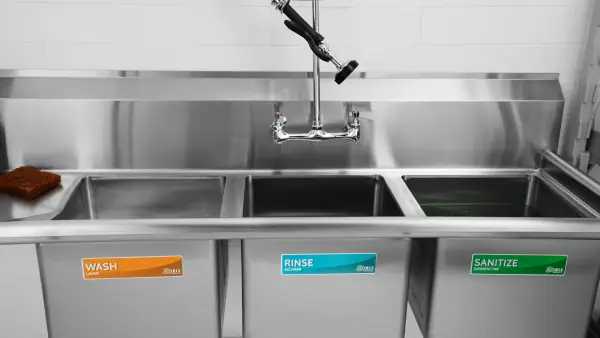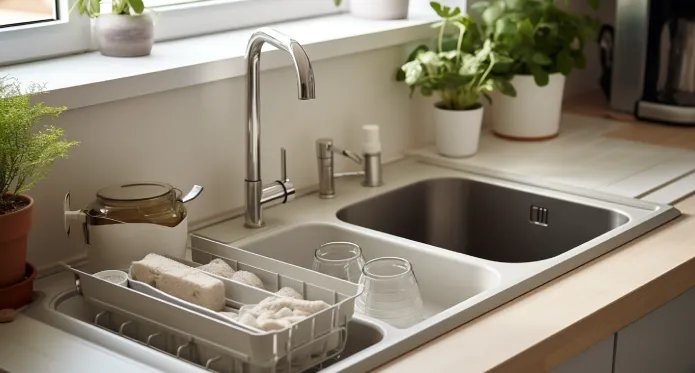Last Updated on November 14, 2023
In your home kitchen, the three-compartment sink stands as your trusty ally in the relentless battle for cleanliness and hygiene. It’s not just a sink; it’s a precise system that is meticulously designed to ensure your dishes emerge sparkling clean and safe for you and your family.
The procedure for washing your dirty dishes in a 3-compartment sink is straightforward. On sink 1, you need to scrub away the dishes to get rid of stubborn food particles and grime.
To ensure no soap residue remains, rinse them thoroughly in the sink 2. The 3rd sink is used to sanitize dishes using a chemical solution or scalding hot water.
We will discuss all the steps in more detail so you can wash your kitchen dishes correctly in a 3-compartment sink.
3 Compartment Kitchen Sink Washing Procedure: Step-By-Step Guide

To wash your kitchen dishes in a three-basin sink, follow these steps:
- Step 1: Prepare the 3-compartment kitchen sink
- Step 2: Scrap and prepare the dishes
- Step 3: Wash the dirty dishes in sink 1
- Step 4: Rinse the dirty dishes in sink 2
- Step 5: Sanitize the dirty dishes in sink 3
- Step 6: Air dry
Check out each step in detail so you can use a 3-compartment sink to clean your dishes efficiently.
Step 1: Prepare the 3 Compartment Kitchen Sink
To begin, make sure you thoroughly clean and sanitize the 3 compartment kitchen sink, removing any residue or contaminants. Check for any leftover food particles, soap, or other substances from previous use.
Use a suitable cleaning agent and scrub the sink thoroughly, paying attention to all corners and edges. Rinse it well to ensure no cleaning residue remains.
Step 2: Scrap and Prepare the Dishes
After you have prepared the three-compartment kitchen sink itself, you should gather all of your dirty dishes, utensils, and kitchen equipment that need to be cleaned.
Before washing the dishes in the 3-compartment sink, scrap any food particles or debris with a rubber scraper or spatula on the dishes.
Be sure to remove any large food debris, as it can block the drain and harbor harmful bacteria.
Step 3: Wash the Dirty Dishes in Sink 1
The first sink in the three-part sink method is designated for washing dishes.
To begin, fill this sink with warm, soapy water. The water should be at least 110 degrees Fahrenheit to remove any grease or grime on the dishes effectively.
Next, put on your latex or neoprene dishwashing gloves and a waterproof dishwasher apron. Place the scraped dishes into the soapy water and use a scrubber or sponge to wash them thoroughly.
Pay special attention to areas with stubborn residue, like the bottoms of pans and utensils. Once the dishes are clean, move them to the next sink for rinsing.
Step 4: Rinse the Dirty Dishes in Sink 2
After washing the dishes in the first sink, the second sink is designated for rinsing. Use water that is at least 110 degrees Fahrenheit and rinse each dish thoroughly.
Make sure to rinse each dish thoroughly, as residual soap can cause stomach upset or allergic reactions in some people.
Step 5: Sanitize the Dishes in Sink 3
Sink 3 is dedicated to sanitizing your dishes. You have two options for sanitizing: using a chemical sanitizing solution or hot water sanitization.
- Chemical Sanitizing Solution
Prepare a sanitizing solution using chlorine bleach, quat (QAC), or iodine. Follow the manufacturer’s instructions for proper dilution.
Submerge each dish in the sanitizing solution for the recommended time, typically around 30 seconds.
Ensure that the solution is at the correct temperature. For chlorine solution, it should be between 75-120° F; for quat solution, between 75-90° F; and for iodine solution, 75° F.
Take care not to mix different sanitizing solutions, as they may produce harmful reactions.
- Hot Water Sanitization
You can use hot water, heated to a minimum temperature of 171 degrees Fahrenheit, and immerse each dish in the scalding water for at least 30 seconds to effectively sanitize them. It is a highly effective method to kill bacteria and eliminate germs on your dishes.
Step 6: Air Dry
Just place your sanitized dishes on the clean drying rack and let them air dry naturally, ensuring a contamination-free environment.
Avoid using towels, as they can reintroduce germs. Give your dishes ample space on the drying rack or drainboard for efficient drying.
How often should you change the water in your three-compartment sink?
You should change the water in each sink of your three-part sink whenever it appears dirty or contaminated. Frequent water replacement is crucial to maintain cleanliness and ensure the effectiveness of the dishwashing process.
In a 3-compartment sink, regularly refreshing the water prevents cross-contamination and maintains high hygiene standards.
Which activities aren’t allowed in a 3-compartment sink?
It is not permitted to use a 3-compartment sink beyond washing, rinsing, and disinfecting dishes. You can’t use it for activities like handwashing or mopping.
By strictly limiting the sink’s use to dishwashing processes, you can prevent cross-contamination and uphold food safety standards. It ensures the sink remains contaminant-free and maintains the necessary hygiene levels.
What materials are suitable for a three-compartment sink in a home kitchen?

When considering materials for a sink with three compartments in the kitchen, stainless steel is the most suitable choice.
Stainless steel sinks are available in various series, with the most common being 304 stainless steel, which is considered the standard. This type of stainless steel is durable, resistant to corrosion from cleaning agents, and well-suited for everyday kitchen use.
However, there are options like 403 stainless steel, which is of lower quality and less resistant to corrosion, and 316 stainless steel, known for its high corrosion resistance, making it a marine-grade steel.
While 304 stainless steel is suitable for most home kitchens, those in coastal or high-humidity areas might opt for the more corrosion-resistant 316 stainless steel.
In any case, stainless steel is preferred for ensuring longevity and hygiene in a sink with three compartments.
Embrace Effortless Hygiene: Properly Use the Sink with Three Compartments
The three-compartment sink becomes an invaluable tool in your home kitchen, ensuring that your dishes shine and are free from harmful bacteria.
You can maintain the highest standards of cleanliness and food safety by properly preparing, washing, rinsing, and sanitizing your dishes. Change the water whenever it appears dirty, and always limit the sink’s use to dishwashing tasks.
This way, you can ensure the longevity of your sink, and a safe and healthy kitchen environment. So, incorporate these washing steps in your dishwashing routine and enjoy effortless hygiene.

